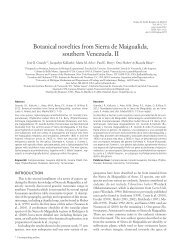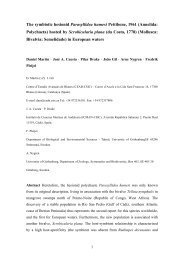Laser Synthesis and Luminescence Properties of SrAl2O4 ... - CSIC
Laser Synthesis and Luminescence Properties of SrAl2O4 ... - CSIC
Laser Synthesis and Luminescence Properties of SrAl2O4 ... - CSIC
Create successful ePaper yourself
Turn your PDF publications into a flip-book with our unique Google optimized e-Paper software.
decay curves. Fluorescence emission <strong>and</strong> excitation spectra were obtained at RT by<br />
exciting the samples with a 1000W ORIEL 66187 tungsten halogen lamp <strong>and</strong> a double<br />
0.22 m SPEX 1680B monochromator. For the emission spectra, the excitation was<br />
carried out at 360 nm. For the excitation spectra the emission was detected at 520nm<br />
using a 0.5 JARREL-ASH monochromator with a Hamamatsu R928 photomultiplier<br />
tube. All optical spectroscopy measurements were corrected from the system response.<br />
Emission decay curves were obtained by pulse excitation with a N2 pumped dye laser<br />
(pulse duration 2ns). Lifetime measurements were carried out using a digital storage<br />
oscilloscope triggered by the laser.<br />
3. Results <strong>and</strong> discussion<br />
The laser melting method reported here yields roughly 0.5 g <strong>of</strong> product per<br />
second. The material obtained has a granular appearance, as expected for a<br />
polycrystalline material obtained at a relatively fast solidification rate from a melt. Fig.<br />
2 shows photographs <strong>of</strong> doped <strong>SrAl2O4</strong> phosphors sinthesized by this laser method. An<br />
afterglow image <strong>of</strong> <strong>SrAl2O4</strong>:Eu 2+ , Dy 3+ is shown in Fig. 2b, where the greenish emission<br />
is clearly observed when UV illumination is removed. <strong>SrAl2O4</strong>:Eu 2+ afterglow,<br />
however, can only be perceived upon UV illumination.<br />
The crystalline phase composition <strong>of</strong> the synthesized phosphors has been<br />
analyzed by XRD (Fig. 3). The diffraction peaks can be indexed to a monoclinic<br />
<strong>SrAl2O4</strong> phase (JCPDS 34–0379). These results are consistent with the fact that phase<br />
changes due to substitution by rare earth ions are not detected by this technique,<br />
particularly at the typically low percentage levels <strong>of</strong> doping required for the observation<br />
<strong>of</strong> efficient luminescence. Within sensitivity <strong>of</strong> XRD, no secondary phases were<br />
detected.

















